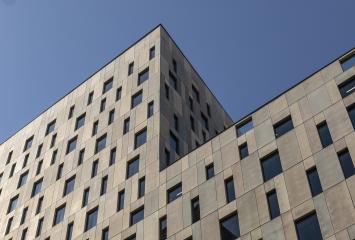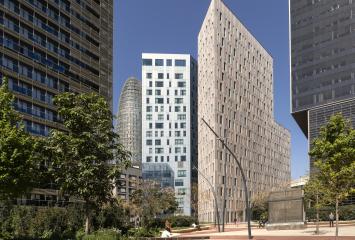The Influence of Architecture on Well-being
According to the National Survey of Human Activity Patterns in the United States, individuals spend approximately 90% of their time indoors, primarily in their homes and workplaces. This reality has spurred the emergence and evolution of a new architectural trend known as neuro-architecture. Through the analysis of the relationship between buildings and human emotions, neuro-architecture aims to inspire constructions that positively impact people's well-being. Specifically, this study has led to a series of architectural changes in offices that are already affecting the happiness of workers. Let's explore them:
Integration with the Environment
Socialization and the sense of being an active part of a community are essential for human well-being. Neuro-architecture emphasizes the value of integrated location, placing office buildings in environments that offer balance, accessibility, and connectivity for workers. This includes services and optimal transportation options, making their lives simpler and enhancing satisfaction.
Natural Lighting
Artificial lighting dominated offices for many decades. However, recent scientific research has confirmed the importance of natural light in people's mood. New offices are designed and built to harness natural sunlight, incorporating measures such as optimal orientation, large windows, and the use of light colors to enhance natural illumination.
Greener Spaces Than Ever
The latter half of the 20th century witnessed a progressive abandonment of rural and natural elements in favor of urbanization. However, this urbanization doesn't have to exclude greenery; it was simply being approached incorrectly. Following numerous studies demonstrating the positive impact of plants on the human psyche, there is a shift towards prioritizing the inclusion of green spaces both inside and around offices. Biophilic design is here to stay.
Ergonomics
The evolution in office design is reflected in ergonomic interior design. Rather than workers adapting to the workplace, the modern workplace is versatile enough to accommodate the needs of the workers at any given moment.This is what we know as ergonomic interior design. This includes chairs of various geometries and heights, sofas for working with laptops, and, in some cases, even hammocks. The focus is on the comfort of the worker.
Acoustic Isolation
Excessive noise increases stress levels, adversely affecting people's mood, professional performance, and management of social and work relationships. Thanks to neuro-architecture, builders are investing more in acoustic isolation mechanisms, resulting in a more serene, productive, and pleasant office environment. The same can be said for thermal isolation, as thermal comfort has become a priority.
Non-Monotonous Design
The traditional office image is often associated with monotony—gray surroundings, identical furniture, and a lack of aesthetically pleasing elements that evoke positive feelings. In contrast, the image of a happy office, as shaped by neuro-architecture, embraces minimalism with a diversity of shapes and colors that stimulate the senses, promoting fulfillment and creativity. These are complex structures that offer a lot without being overwhelming.
Meeting Spaces
Perhaps the most characteristic aspect of a happy office is the existence of meeting spaces where workers have the opportunity to converse and participate in collective activities. The classic cubicle office was contrary to the care of human happiness; isolation leads to serious emotional issues. Sharing feelings and thoughts is crucial, pointing towards the office of the future, where design maximizes the potential of synergies.

